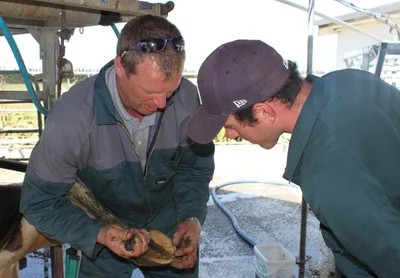Raising the standard of hoof care

Hoof health is a million dollar problem for the nation's dairy herds and should get more focus, according to a Mid Canterbury hoof care specialist.
VeeHof founder and hoof trimming trainer Fred Hoekstra said lameness ranked in the top three for bovine health issues on dairy farms in New Zealand.
It cost the industry millions of dollars each year.
“Lame cows don’t walk well, don’t eat well, and don’t produce.”
It was an animal welfare issue and also an economic issue for farmers.
“Nobody benefits from lame cows – and that includes hoof trimmers,” he said.
Hoekstra, a qualified hoof trimmer and instructor in the Dutch trimming method, came to New Zealand 32 years ago.
Cattle hoof trimming was well known in Europe at the time. But there were no professional hoof trimmers in New Zealand back then, Hoekstra said.
He saw a gap and set up Veehof, eventually settling in Mid Canterbury with his wife, Sandy, offering hoof trimming services and products.
Since then, his track record helped build up rapport and trust with farmers to the point where VeeHof has 20 to 25 hoof trimmers working throughout New Zealand. Most have been trained by Hoekstra.
“Cows in New Zealand do not spend as much time on concrete and do not need to be regularly trimmed like they do in Europe and USA.”
Hoekstra said catching lameness before it became obviously painful was the most effective option for New Zealand herds.
“Preventative trimming is more cost-effective than curing lameness, which includes treatment costs and a loss in milk yields.”
Monitoring the locomotion of the herd over time was the best way to identify issues before they become a problem.
Trimming helped to redistribute the weight of the cow. However, there was more to hoof health than trimming, he said.
The cow’s diet affected the health of the live tissue within the hoof.
Another contributor to lameness was the lack of time cows had to rest, relax, socialise and ruminate in the pasture.
Farmers who ran large mobs of cattle for efficiency put their cows under extra stress, Hoekstra said.
“Cows should ideally spend between 20 and 22 hours on pasture. But most cows in New Zealand spent much less time in the paddock.”
It could take an hour to get the herd to the shed, an hour-and-a-half to milk the mob, and another hour to turn them out again. When this happened twice a day it added up, Hoekstra said.
Hoekstra said hoof trimmers were usually called in when a lame cow was struggling to walk and were seen as “the ambulance at the bottom of the cliff”.
He said early detection and early response – effectively used hoof trimmers as a barrier at the top of the cliff – was far more cost-effective for farmers.
In 2019, Hoekstra’s set up the Dairy Hoof Care Institute to raise the standard of hoof care in New Zealand.
They offer a one-day introductory course on hoof health and trimming and an intensive course with an initial five-day course, with three refresher days and the option to take an exam to get an internationally industry recognised diploma.
Hoekstra also teaches his hoof-trimming method to veterinary graduates for Massey University.
By Sharon Davis

